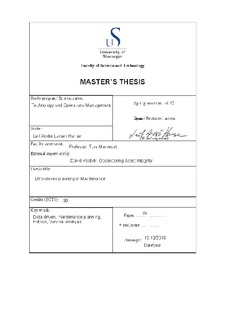Data-driven planning of maintenance
Master thesis
Permanent lenke
http://hdl.handle.net/11250/2448199Utgivelsesdato
2016-12-15Metadata
Vis full innførselSamlinger
- Studentoppgaver (TN-ISØP) [1459]
Sammendrag
The purpose of this master thesis is to develop data-driven mathematical models to “simulate” an equipment lifecycle over a period of time to reveal the associated effects like survival curve and hazard rate. The failure frequency or the hazard rate is input to a cost/benefit analysis with cost of failure and cost of maintenance to find the optimal maintenance interval. Furthermore a baseline preventive maintenance program made with Reliability Centred Maintenance methodology is compared with the PM-program optimized with use of the data-driven methodology.
The model is tested and used with a sample size of 100, random sampled over a period of 10 years and uses OREDA failure mode dataset with Mean failure rates as input. Survival Analysis is developed with use of Lifelines resulting into estimated survival (reliability) function with and the Kaplan Meier estimate and estimated Hazard rate with the Nelson Aalen estimate.
The study shows potentials of cost savings using data-driven modelling; however the most beneficial is that the data-driven modelling results into a decision basis for cost/benefit analysis for optimizing maintenance. Decision basis support like chance of asset survival for a given time interval, MTTF (Mean Time To Failure) and hazard rate.
Last but not least recommendations for further work are discussed.
Beskrivelse
Master's thesis in Offshore technology: Technology and Operations Management
